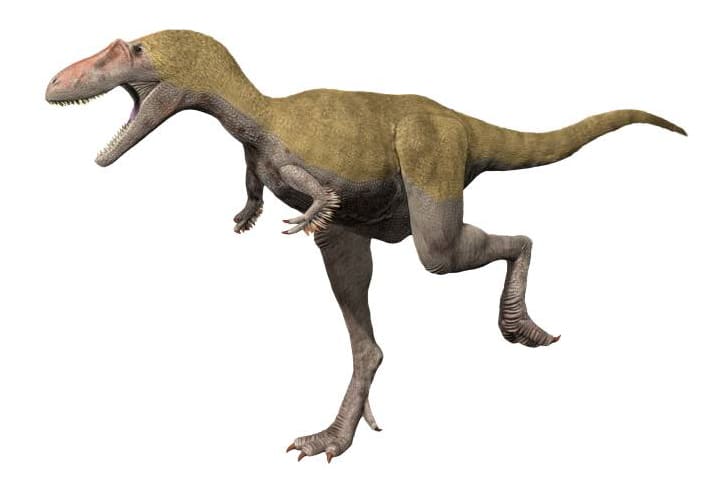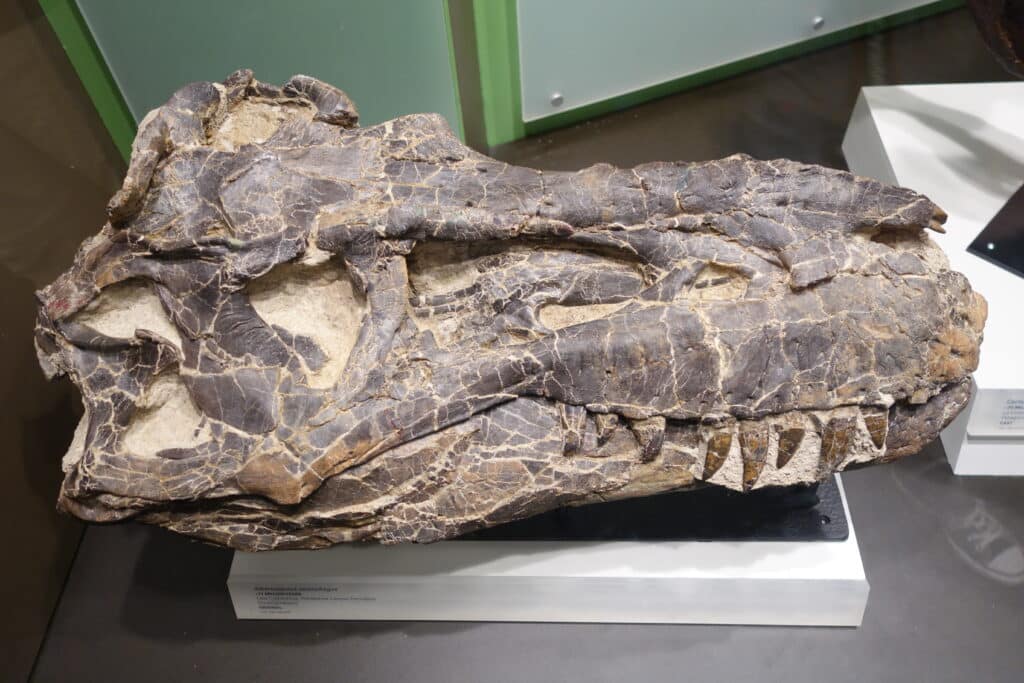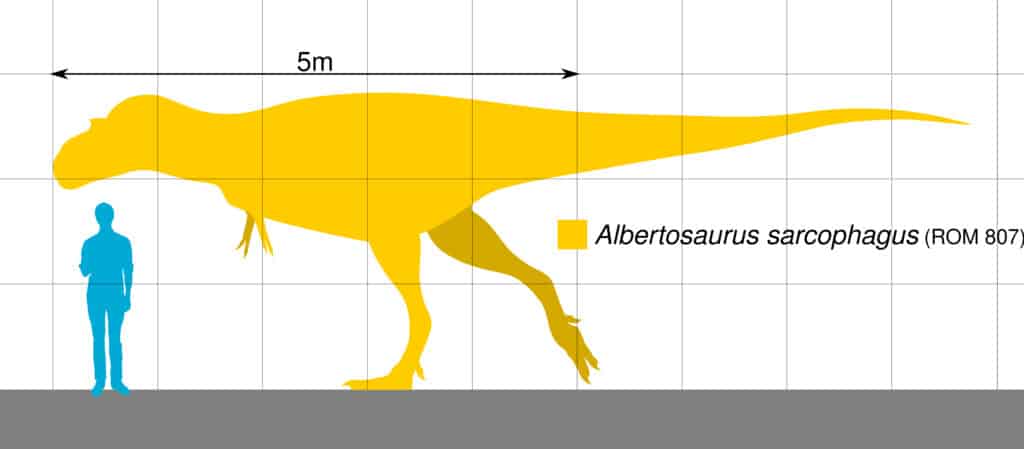In the annals of prehistoric life, few creatures command as much attention and fascination as the dinosaurs. Among these ancient beasts, the Albertosaurus holds a special place. This large tyrannosaurid dinosaur, whose name means “Alberta lizard,” lived in northwestern North America during the early to middle Maastrichtian age of the Late Cretaceous period–about 71 million years ago. Its discovery has provided scientists with a wealth of information about its anatomy, behavior, and its environment.
The Albertosaurus was a formidable predator characterized by its bipedal stance, short arms, and a massive head filled with dozens of large, sharp teeth. Despite its fearsome appearance, it was much smaller than its more famous relative, the Tyrannosaurus rex. However, what it lacked in size it made up for in agility and adaptability, making it a top predator in its ecosystem.
Albertosaurus Key Facts
| Keyword | Fact |
|---|---|
| Albertosaurus pronunciation | al-br-tuh-saw-ruhs |
| Meaning of name | “Alberta lizard” |
| Group | Tyrannosauridae |
| Diet | Carnivore |
| When it Lived | 83.5 to 66.0 MYA |
| Period | Late Cretaceous |
| Epoch | Late/Upper Campanian to Lancian |
| Length | 30.0 ft |
| Height | 11.0 ft |
| Weight | 1.3 to 2.0 tons |
| Mobility | Moved on two legs |
| First Discovery | 1884 by Joseph Burr Tyrrell |
| Location of first find | Alberta, Canada |
| First Described by | 1905 by Henry Fairfield Osborn |
| Holotype | CMN 5600 |
Albertosaurus Origins: Taxonomy, Timeline, and Discovery
The Albertosaurus, named by Henry Fairfield Osborn in 1905, belongs to the Saurischia clade, which includes all carnivorous dinosaurs, and the Theropoda family, which encompasses all bipedal dinosaurs. It belongs to the Tyrannosauridae family, specifically the Albertosaurinae subfamily. The binomial name of its type species is Albertosaurus sarcophagus.

This predator lived during the Maastrichtian age of the Late Cretaceous period. This was a time when the Earth was warm and sea levels were high, creating a landscape of shallow inland seas and lush vegetation.The first fossil was discovered in 1884 by Joseph Burr Tyrrell, a geologist with the Geological Survey of Canada. The discovery was made near the Red Deer River in Alberta, Canada, which is how the dinosaur got its name. The specific name, “sarcophagus,” is derived from the Ancient Greek term σαρκοφάγος (sarkophagos), meaning “flesh-eating.”
Listen to Pronunciation
Fossil Evidence
This is one of the best-known tyrannosaurids due to the discovery of more than 30 individuals that provide a detailed understanding of its anatomy. The most significant find is the Dry Island bonebed, discovered by American paleontologist Barnum Brown in 1910, which contained the remains of 26 individuals of various ages.

Later finds have revealed more about its life history and behavior. For example, a study of the growth rates of these dinosaurs, based on the analysis of bone rings, suggested that they grew rapidly during their first decade of life, reaching adult size by about 16 years. This rapid growth rate is consistent with other tyrannosaurids.
The fossils of this genus are generally well-preserved, with many complete skulls and skeletons found. This has allowed scientists to study the dinosaur’s physical characteristics in detail, including its body shape, head, neck, vertebrae, limbs, tail, and skin.
Albertosaurus Size and Description
The Albertosaurus was a large, bipedal predator that dominated its environment. Its body was built for hunting with a large head, sharp teeth, and powerful legs. Despite its size, it was likely an agile creature, capable of quick movements to catch its prey.
Short description of Albertosaurus
It had a streamlined body, with a large skull and a long, heavy tail that helped to balance its body when it was running. Its arms were short and had two clawed fingers, while its hind legs were long and muscular, ending in a large, three-toed foot with sharp claws. The skin was likely covered in scales, similar to modern reptiles.
Size and Weight of Type Species
This carnivorous dinosaur was smaller than its famous relative, the Tyrannosaurus rex, but it was still a large dinosaur. An adult measured up to 30 feet in length and stood about 11 feet tall at the hips. Estimates of its weight vary, with some suggesting it weighed between 1.3 to 1.7 tons, while others propose a weight of up to 2 tons.

The Ultimate Dino Quiz
Do you want to test your knowledge of dinosaurs? Then try this Ultimate Dino Quiz! Don’t worry if you get some of the answers wrong, and look at it as an opportunity to refresh and improve your knowledge!
Don’t forget to try our other games as well!
The Dinosaur in Detail
The Albertosaurus was a unique creature with several features that set it apart from other dinosaurs. Its large, banana-shaped teeth were designed for ripping and tearing flesh rather than chewing. These teeth were continually replaced throughout the dinosaur’s life to ensure it always had a sharp set of tools for feeding.
Its gregarious behavior is one of its most intriguing characteristics. Evidence from the Dry Island bonebed suggests that these dinosaurs may have lived in social groups, a behavior rarely seen in large theropods. This social behavior may have been a key factor in the dinosaur’s success, allowing it to hunt in packs and take down larger prey.
It also had a keen sense of smell, which would have been useful for tracking prey and avoiding danger. Its large olfactory bulbs and nerve channels suggest that it had a highly developed sense of smell, possibly even better than that of modern dogs.
The Albertosaurus in its Natural Habitat and Environment
During the Late Cretaceous period, the Earth was warm and the sea levels were high. Our dinosaur inhabited the prehistoric continent of Laramidia, made up by the western part of present-day North America. The environment was likely a mix of forest and open plains, with a variety of vegetation including ferns, conifers, and flowering plants.
As a large carnivore, this predator would have been at the top of the food chain. Its diet likely consisted of large herbivorous dinosaurs, although it may have also scavenged on carcasses. The dinosaur’s speed and agility combined with its sharp teeth and powerful jaws would have made it a formidable predator.
It was a bipedal dinosaur, moving on two sturdy legs. This would have given it an advantage in terms of speed and agility, allowing it to chase down prey and avoid predators. It is also possible that it lived in social groups, which would have allowed it to hunt cooperatively and defend itself against threats.
Interesting Points about Albertosaurus
- It is named after Alberta, Canada, where the first specimen was found.
- Unlike many large theropods, it may have lived in social groups, a behavior suggested by the discovery of multiple individuals at a single site.
- It had a rapid growth rate, reaching adult size within as little as 16 years.
- Despite its size, it was likely an agile predator, capable of quick movements to catch its prey.
- It had a highly developed sense of smell, possibly even better than that of modern dogs.
Contemporary Dinosaurs
In the grand theater of the Late Cretaceous period, the Albertosaurus, a formidable carnivore, shared its world with a captivating cast of contemporary Laramidian dinosaurs. Each of these dinosaurs, unique in their own right, contributed to the intricate symphony of survival, their lives interwoven in a complex ballet of coexistence and competition.
The Edmontosaurus, a herbivore of considerable size, may have been a frequent sight for the Albertosaurus. Despite its smaller stature, the Edmontosaurus was no easy prey. Its sheer speed and agility could have made it a challenging target, a tantalizing dance of predator and prey playing out on the prehistoric stage. The Triceratops, with its iconic frill and formidable horns, presented a stark contrast. This dinosaur, larger and more robust, could have been a formidable opponent for our main dinosaur, a testament to the balance of power in this ancient world.
The Ankylosaurus, armored and unyielding, would have been a sight to behold for the Albertosaurus. Its formidable defensive adaptations, including a massive club-like tail, could have deterred even the most determined predators. This interaction paints a vivid picture of the survival strategies employed by these prehistoric creatures, a constant game of adaptation and counter-adaptation.
Lastly, the Pachyrhinosaurus, with its thick-skulled head and robust body, adds another layer to this dynamic ecosystem. Its unique nasal boss, a large, bony structure replacing the typical nasal horn of other ceratopsids, could have been a point of curiosity for the Albertosaurus. This dinosaur, while not as large as the Triceratops, still presented a challenge for any potential predator, further illustrating the delicate balance of this prehistoric ecosystem.
Featured Image Credit: Nobu Tamura , CC BY-SA 4.0, via Wikimedia Commons
Sources
https://www.app.pan.pl/archive/published/app58/app20110141.pdf
https://besjournals.onlinelibrary.wiley.com/doi/10.1111/2041-210X.12226
https://www.app.pan.pl/archive/published/app48/app48-191.pdf
https://www.researchgate.net/publication/40661587_The_Dinosauria_second_edition
The information in this article is based on various sources, drawing on scientific research, fossil evidence, and expert analysis. We aim to provide a comprehensive and accurate overview of the dinosaurs. However, please be aware that our understanding of dinosaurs and their world is constantly evolving as new discoveries are made.”
This article was last fact checked: Joey Arboleda – 06-09-20223
